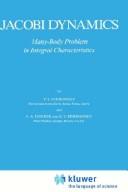| Listing 1 - 3 of 3 |
Sort by
|
Book
ISBN: 9400797907 940075907X 9400759088 1299408044 Year: 2013 Publisher: Dordrecht : Springer,
Abstract | Keywords | Export | Availability | Bookmark
 Loading...
Loading...Choose an application
- Reference Manager
- EndNote
- RefWorks (Direct export to RefWorks)
Analysis of the orbital motion of the Earth, the Moon and other planets and their satellites led to the discovery that all bodies in the Solar System are moving with the first cosmic velocity of their protoparents. The mean orbital velocity of each planet is equal to the first cosmic velocity of the Protosun, the radius of which is equal to the semi-major axis of the planet’s orbit. The same applies for the planets’ satellites. All the small planets, comets, other bodies and the Sun itself follow this law, a finding that has also been proven by astronomical observations. The theoretical solutions based on the Jacobi dynamics explain the process of the system creation and decay, as well as the nature of Kepler’s laws.
Solar system -- Origin. --- Solar system. --- Space astronomy. --- Astronomy & Astrophysics --- Physical Sciences & Mathematics --- Astronomy - General --- Astrophysics --- Solar system --- Age. --- Physics. --- Geophysics. --- Planetology. --- Astronomy. --- Astrophysics. --- Cosmology. --- Astronomy, Astrophysics and Cosmology. --- Geophysics/Geodesy. --- Milky Way --- Physical geography. --- Planetary sciences --- Planetology --- Geography --- Geological physics --- Terrestrial physics --- Earth sciences --- Physics --- Astronomical physics --- Astronomy --- Cosmic physics --- Origin. --- Deep space

ISBN: 9027724180 940108629X 940094800X Year: 1987 Volume: vol 130 Publisher: Dordrecht ; Boston, MA : D. Reidel,
Abstract | Keywords | Export | Availability | Bookmark
 Loading...
Loading...Choose an application
- Reference Manager
- EndNote
- RefWorks (Direct export to RefWorks)
Astrofysica --- Astronomical physics --- Astronomische fysica --- Astrophysics --- Astrophysique --- Dynamica --- Dynamics --- Dynamique --- Fysica [Astronomische ] --- Hamilton-Jacobi [Equations d' ] --- Hamilton-Jacobi [Vergelijkingen van ] --- Hamilton-Jacobi equations --- Many-body problem --- Physics [Astronomical ] --- Physique astronomique --- Problem of many bodies --- Problem of n-bodies --- Probleme a n corps --- n-body problem --- n-lichaamprobleem --- Dynamics. --- Hamilton-jacobi equations --- Many body problem
Book
ISBN: 9400704976 9400704984 Year: 2011 Publisher: Dordrecht : Springer Science,
Abstract | Keywords | Export | Availability | Bookmark
 Loading...
Loading...Choose an application
- Reference Manager
- EndNote
- RefWorks (Direct export to RefWorks)
In their approach to Earth dynamics the authors consider the fundamentals of Jacobi Dynamics (1987, Reidel) for two reasons. First, because satellite observations have proved that the Earth does not stay in hydrostatic equilibrium, which is the physical basis of today’s treatment of geodynamics. And secondly, because satellite data have revealed a relationship between gravitational moments and the potential of the Earth’s outer force field (potential energy), which is the basis of Jacobi Dynamics. This has also enabled the authors to come back to the derivation of the classical virial theorem and, after introducing the volumetric forces and moments, to obtain a generalized virial theorem in the form of Jacobi’s equation. Thus a physical explanation and rigorous solution was found for the famous Jacobi’s equation, where the measure of the matter interaction is the energy. The main dynamical effects which become understandable by that solution can be summarized as follows: • the kinetic energy of oscillation of the interacting particles which explains the physical meaning and nature of the gravitation forces; • separation of the shell’s rotation of a self-gravitating body with respect to the mass density; difference in angular velocities of the shell rotation; • continuity in changing the potential of the outer gravitational force field together with changes in density distribution of the interacting masses (volumetric center of masses); • the nature of the precession of the Earth, the Moon and satellites; the nature of the rotating body’s magnetic field and the generation of the planet’s electromagnetic field. As a final result, the creation of the bodies in the Solar System having different orbits was discussed. This result is based on the discovery that all the averaged orbital velocities of the bodies in the Solar System and the Sun itself are equal to the first cosmic velocities of their proto-parents during the evolution of their redistributed mass density. Audience The work is a logical continuation of the book Jacobi Dynamics and is intended for researchers, teachers and students engaged in theoretical and experimental research in various branches of astronomy (astrophysics, celestial mechanics and stellar dynamics and radiophysics), geophysics (physics and dynamics of the Earth’s body, atmosphere and oceans), planetology and cosmogony, and for students of celestial, statistical, quantum and relativistic mechanics and hydrodynamics.
Astrophysics. --- Dynamics. --- Hamilton-Jacobi equations. --- Many-body problem. --- Astronomy & Astrophysics --- Engineering & Applied Sciences --- Physical Sciences & Mathematics --- Applied Mathematics --- Astronomy - General --- Astrophysics --- Astronomical physics --- Equations, Hamilton-Jacobi --- Equations, Jacobi-Hamilton --- Jacobi-Hamilton equations --- Dynamical systems --- Kinetics --- n-body problem --- Problem of many bodies --- Problem of n-bodies --- Astronomy. --- Physical geography. --- Astronomy, Astrophysics and Cosmology. --- Geophysics/Geodesy. --- Remote Sensing/Photogrammetry. --- Astronomy --- Cosmic physics --- Physics --- Calculus of variations --- Differential equations, Partial --- Hamiltonian systems --- Mechanics --- Mathematics --- Mechanics, Analytic --- Force and energy --- Statics --- Geography --- Geophysics. --- Remote sensing. --- Remote-sensing imagery --- Remote sensing systems --- Remote terrain sensing --- Sensing, Remote --- Terrain sensing, Remote --- Aerial photogrammetry --- Aerospace telemetry --- Detectors --- Space optics --- Geological physics --- Terrestrial physics --- Earth sciences
| Listing 1 - 3 of 3 |
Sort by
|

 Search
Search Feedback
Feedback About UniCat
About UniCat  Help
Help News
News